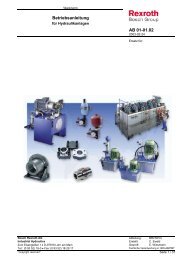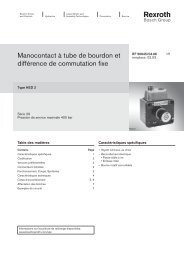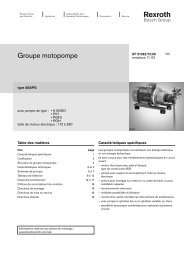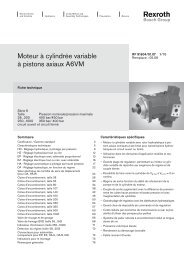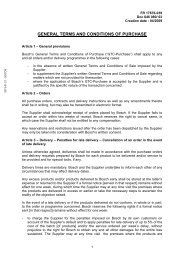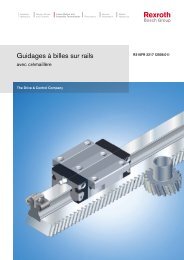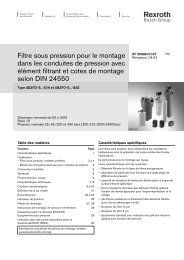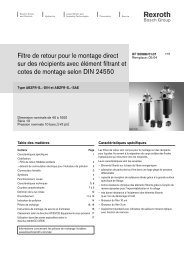MLD-S Tech-FB Library Description - Bosch Rexroth
MLD-S Tech-FB Library Description - Bosch Rexroth
MLD-S Tech-FB Library Description - Bosch Rexroth
Create successful ePaper yourself
Turn your PDF publications into a flip-book with our unique Google optimized e-Paper software.
1-44 <strong>MLD</strong>-S <strong>Tech</strong>nology <strong>Library</strong> <strong>Rexroth</strong> <strong>MLD</strong>-S <strong>Tech</strong>-<strong>FB</strong> <strong>Library</strong><br />
1.9 Adjustment Function Blocks<br />
Introduction and Overview<br />
Basic Principle<br />
⎡ Degree⎤<br />
AlterationVelocity<br />
⎢ ⎥<br />
= Increments<br />
⎣ s ⎦<br />
With the function blocks:<br />
• MX_ContinuousAdjustType01<br />
• MX_ContinuousAdjustType02<br />
• MX_IncrementalAdjustType01<br />
PLC-Variables can be changed (jogged) continuously or incrementally via<br />
binary inputs.<br />
• The operation must be stopped via a binary input (Enable).<br />
• The selected variable can be changed continuously with the function<br />
blocks MX_ContinuousAdjustType01 or MX_ContinuousAdjustType02<br />
(similar to long jog in SYNAX).<br />
• The affected variable can be changed incrementally with the function<br />
MX_IncrementalAdjustType01 (similar to short jog in SYNAX).<br />
• The selected variable can be incremented and decremented within the<br />
limit values.<br />
• When reaching a limit value (HighLimitAck= TRUE or LowLimitAck=<br />
TRUE), the continuous adjustment deactivates, i.e. the function block<br />
no longer adjusts the variable. In this case, the corresponding limit<br />
value, secified with the „HighLimit“ and „LowLimit“ inputs, is output.<br />
• When the limits, „HighLimit“ and „LowLimit“, have the same value as<br />
the specified modulo value, „LowLimit“ is set to zero and „HighLimit“ is<br />
set equal to the modulo value. Thus adjusting is possible over the full<br />
modulo value range.<br />
The alteration velocity characterizes the rate of change of the adjusted<br />
variable. The rate of change depends on the increments and the number<br />
of increments per second. When changing a position, the alteration<br />
velocity is calculated by:<br />
1<br />
⎢<br />
⎣s<br />
⎡ ⎤<br />
[ Degree] * Increments per Second<br />
⎥ ⎦<br />
If, for example, the revolution speed of the virtual master axis is altered,<br />
the alteration velocity is calculated by:<br />
⎡r.<br />
p.<br />
m.<br />
⎤<br />
AlterationVelocity<br />
⎢ ⎥<br />
= Increments<br />
⎣ s ⎦<br />
1<br />
⎢<br />
⎣s<br />
⎡ ⎤<br />
[ r.<br />
p.<br />
m.<br />
]*<br />
Increments per Second<br />
⎥ ⎦<br />
Adjustment Limits<br />
Basic Rules<br />
While the adjustment signal is active, the influenced variable is adjusted<br />
with the defined velocity.<br />
The adjustment can only occur via the corresponding inputs if they are<br />
within the specified limits.<br />
Exception: If the start value of the influenced variable is outside the<br />
specified limits, the influenced variable can only be modified in the<br />
direction of the valid range. If a modulo value is specified, the influenced<br />
variable can be modified in both directions. After reaching the valid range,<br />
it is impossible to move the variable outside this range.<br />
• When both adjustment signals (Inc/Dec) = TRUE simultaneously, both<br />
signals are evaluated as FALSE.<br />
• An adjustment signal with that changes polarity causes an immediate<br />
inversion of the direction. Also, the current adjustment is not finished.<br />
DOK-<strong>MLD</strong>-S*-<strong>Tech</strong><strong>FB</strong>*****-AW01-EN-D






